|
Each mortuary contact was sent an organisational questionnaire for completion. The aim
of this questionnaire was to provide NCEPOD with information on the facilities available for pathologists performing postmortem examinations. A copy of this questionnaire can be found as an appendix.
Two key issues that emerged from the organisational questionnaire were related to health and safety and clinical pathology accreditation (CPA) and these are discussed in detail throughout this section.
Age of mortuaries
The median age of the mortuaries was 25 years (in terms of time between the mortuaries being built and refurbished). The median length of time between 2005 and the date of the last refurbishment was seven years (Table 1).
| Table 1: Age of mortuaries |
| |
Age of mortuaries, between being built and being refurbished (years) |
Length of time from last refurbishment (years) |
| Median (range) |
25 (1-131) |
5.5 (0-26) |
The age of the mortuary was only calculated where both the date of being built and refurbished was given (73/193); these data do not include sites that did not supply a date of refurbishment (and/or newly built mortuaries). The length of time from last refurbishment was calculated in the 59% (114/193) of mortuaries that supplied the data.
Facilities
The mortuary contacts were asked to provide details about the facilities available to them. Seventy five percent (144/193) of the mortuaries were said to have access, or ready access, to x-ray equipment. Of the 49 mortuaries that were reported as not having access to this equipment, 22% (11/49) were local authority mortuaries. Assessment of skeletal injuries may require such examinations, but from this study it was not possible to assess whether lack of radiology impacted on the quality of the autopsies and reports.
All mortuary contacts reported that pathologists had access to an electric skull saw. In 95% (182/192) of mortuaries lighting was described as adequate (one questionnaire remained unanswered) and in only 67% (128/192) of mortuaries were additional spotlights available for use. The median number of tables available for eviscerating bodies was three, (range 1 - 11). Most mortuaries, 93% (179/192) had separate organ dissecting tables and 92% of mortuary contacts (177/193) reported that there was a separate office area to write up or dictate notes.
Moving air ventilation with temperature control was reported to be present in 79% (151/191)
of mortuaries (two questionnaires unanswered). This is of concern as good ventilation is an essential requirement for safe working in a mortuary. The NHS Estates publication, 'Facilities for mortuary and post-mortem [sic] room services', states that adequate ventilation is essential to minimise offensive odours and the risk of infection by contaminated airborne droplets, with air movement from clean to dirty areas where possible1. The process of clinical accreditation can assist in addressing these structural issues, and is a further reason why all mortuaries should be accredited, which is discussed in detail later in this section.
Only 65% (125/193) of mortuaries were reported as having viewing facilities for clinicians. The NHS Estates 'Facilities for mortuary and post-mortem room services' handbook1 describes an observation area as being physically separate from the autopsy room, which is for clinical staff to observe an autopsy. This is not to be confused with the body viewing suite, which is used by relatives.
When examined by mortuary type, only 38% (6/16) of local authority mortuaries had viewing facilities for clinicians compared with 67% (118/175) hospital/combined mortuaries. Obviously, if the pathologist wishes to demonstrate and discuss an autopsy with the relevant clinician (or coroner), adequate viewing facilities are essential. As mortuaries are upgraded, making provision for this should be part of the refurbishment.
Protocols
NCEPOD requested information on whether written protocols were in place for autopsy performance. Ninety three percent (178/192) of mortuaries were said to have written protocols in place (one questionnaire unanswered). Of those mortuaries, 84% (149/177) reported they applied to both pathologists and APTs; 15% (26/177) to APTs only; and 1% (2/177) to pathologists only (one questionnaire unanswered).
The study did not investigate further into what the protocols contained and how detailed
they were.
Workload
Mortuary contacts were asked how many coronial autopsies were performed in the mortuary between 1st April 2004 and 31st March 2005.
| Table 2: Number of coronial autopsies performed in the mortuaries |
| |
Total |
| Median (range) |
472 (4-2017) |
These data were then recoded to give an estimate of the workload of the mortuary. Mortuaries were assigned to one of four groups depending on the number of autopsies performed over
a one year period. The groups were less than 52 a year, (less than one a week); 53 - 520 a year, (10 a week); 521 - 999 a year; and more than 1000 a year (Figure 1).
Figure 1: Mortuary workload
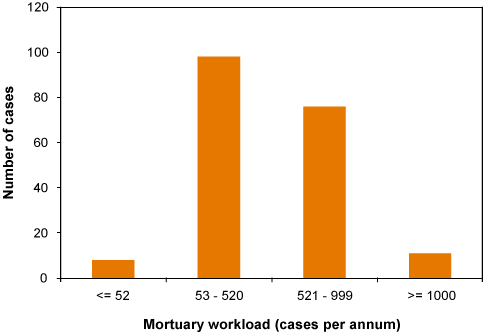
These data show that on average 10 autopsies a week were performed in mortuaries, (98/193); however there were 4% (8/193) where less than 52 a year were performed.
Further analysis compared mortuary workload and mortuary type. It was reported that in
92 of the 175 (52%) hospital/combined mortuaries, between 53 and 520 autopsies were performed per annum; this was closely followed by 66 of the 175 (38%) hospital mortuaries where it was reported between 521 - 999 autopsies were performed per annum. It was stated in a majority of local authority mortuaries, 50% (8/16), between 521 - 999 autopsies were performed per annum. Interestingly it was stated in 13% (2/16) of local authority mortuaries more than 1000 autopsies are performed per annum.
Age of cases accepted for examination
It was stated that in 32% (62/193) of mortuaries autopsies were conducted on all age groups, in 24% (47/193) on adults only and 21% (40/193) on those aged six or over only. In the remainder of mortuaries a number of different combinations of age groups were autopsied.
Staffing
The organisational questionnaire reviewed staffing within mortuaries (Table 3). As the table shows, the number of coroners using the mortuary ranged between 1 and 30. Thirty is thought to be a high number and when the median is examined, it shows a much lower figure. It may have been that the mortuary accepting requests from thirty coroners accepted specialist autopsies, which would account for the much higher than average number of coroners who used the mortuary. In terms of missing data, 100% of respondents gave data on the number of pathologists using the mortuary, 97% (187/193) gave data for the number of coroner's using the mortuary, and 99% (192/193) gave data for the number of APTs assisting with autopsy examinations.
| Table 3: Staffing |
| |
No. of pathologists using mortuary |
No. of coroners using the mortuary |
No. of APTs and other mortuary staff (whole time equivalent) assisting with examinations |
| Median (range) |
10 (1-45) |
2 (1-30) |
2.3 (0.1-9) |
Record keeping
All but one mortuary contact reported that they kept a record of the autopsies performed in their facility. Of these, in most mortuaries, 49% (94/191) of records were stored on both a computer and as a handwritten record (Figure 2). Other modes of storage included copies of the autopsy report; a log book or mortuary register; CD Rom; photocopy of cause of death, or the pathologist kept a record of the report.
Figure 2: Storage of records
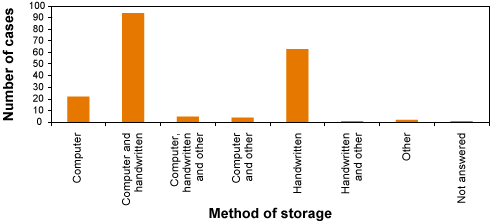
Health and safety
Health and safety concerns over the care of the deceased and the autopsy feature prominently in mortuary management. There are infectious hazards in bodies, from those which are known to harbour a serious communicable disease as well as the others that might do so but have never been tested in life. Protection of health care workers - pathologists and APTs - is a prime concern. This is reflected in the many guidelines and protocols provided by professional bodies and government related bodies on appropriate clothing and personal protective equipment to be used in the examination of the dead2,3. The organisational questionnaire provided information on some aspects of such protection and also gave insight into how mortuaries perceive risk of infection, and what they do about it.
Pathologists' clothing
What pathologists and APTs wear whilst at work in mortuaries has changed significantly over the last 30 years. Once it was traditional to wear a cotton gown (not waterproof) over ordinary day clothes, and replace shoes with rubber boots. As hygiene has improved across all aspects of medicine, so have standards of protective dress in mortuaries been modified. Mortuary contacts were asked what clothing the pathologists wear when performing autopsies. Options were protective clothing over surgical scrubs (i.e. cotton shirt and trousers, after removing day clothes), protective clothing over day clothes, or other. The study did not enquire into the protection of hands, face and eyes whilst performing autopsies.
In 81% (156/193) of mortuaries, the pathologists wore protective clothing over surgical scrubs. That is not 100% and it is not thought to be due to lack of facilities as in 99.5% (192/193) of mortuaries, it was reported there was on-site shower facilities and changing rooms. When looking at the breakdown between hospital/combined mortuaries and local authority mortuaries, in 38% (6/16) of local authority mortuaries the pathologist sometimes wore protective clothing over day clothes, and in 13% (2/16) of local authority mortuaries, always protective clothing over day clothes (Figure 3). Autopsies are often dirty, infective and odorous, and so it is important that all workers are protected (and their outside day clothes) by adopting appropriate standard dress.
Figure 3: Mortuary type and clothing worn by pathologists
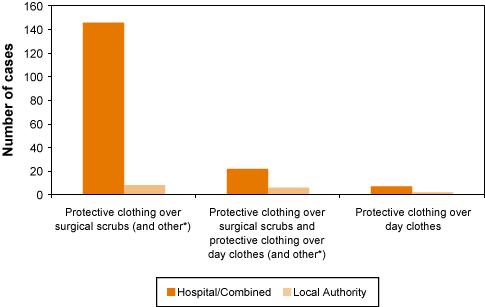
Recommendation
Pathologists should wear protective clothing over appropriate scrub suits, not over their day clothes.
High risk autopsies
Since 1991 there has been national guidelines from the Health Services Advisory Committee on protection against infection risks from bodies3. The RCPath Guidelines on Autopsy Practice (2002) include an extensive section on risk reduction when examining bodies with serious communicable diseases, particularly tuberculosis (TB), Hepatitis C (HCV), Human Immunodeficiency Virus (HIV) and suspected Creutzfeldt-Jakob Disease (CJD); risk reduction because it is impossible completely to eliminate such hazards in practice.
It is realised that mortuaries vary widely in their capacity and willingness to undertake autopsies on bodies that pose a real or perceived infection risk. The coroner advisors were aware that within their jurisdictions some mortuaries will not accept high risk cases, and this causes problems when such a case needs an autopsy, with contacts needing to be made with other mortuaries and pathologists that will accept the case.
Many mortuaries accept all such cases, the only exception being known or suspected Hazard Group 4 infections (viral haemorrhagic fevers) which, fortunately, so rarely present in the UK as not to be a significant problem4. However, the pathology advisors were aware of mortuaries that refuse to examine bodies that are possibly infected including hepatitis B infection (HBV). This is paradoxical since all health care workers are vaccinated against HBV and are required to demonstrate a satisfactory immune response (and the vaccine is truly protective). Coroners are aware of this variation and often resort to sending bodies to a mortuary outside their jurisdiction in order to obtain an autopsy examination on an infected body (which is in fact contrary to the requirement outlined in Section 22 of the Coroners Act 1988, which states that a coroner may order removal of the body to any place wither within his district or within an "adjoining" district). There appears to be no standard governance approach to whether mortuaries accept or refuse work on infected bodies.
NCEPOD asked whether mortuaries accepted cases for autopsy that were considered to be infected with a range of infectious risks, and whether they had protocols to cover the autopsy process (Figure 4).
Figure 4: High risk infectious autopsies
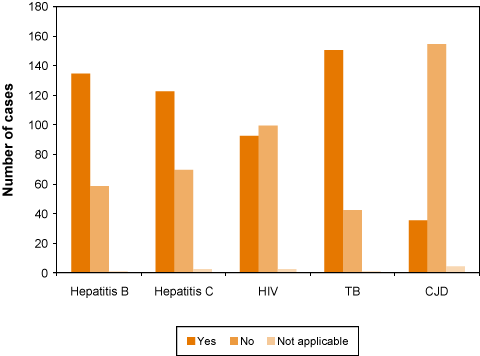
These data are remarkable. Only three quarters of the mortuaries (150/192) would perform autopsies on persons suspected or known to have tuberculosis; for hepatitis B and C infections, the proportions are only two thirds (134/192 and 122/191 respectively). Under half of mortuaries (92/191) would examine those with HIV, and only one fifth (35/189) would examine a person with known or suspected CJD. Of those mortuaries that do carry out infectious autopsies, a majority had written protocols in place, (Hepatitis B 96% (122/127); Hepatitis C 96% (111/122); HIV 95% (83/92); TB 94% (136/150); CJD 97% (34/35).
The organisational questionnaire examined why high risk infectious autopsies were not performed. This was a free text field; however answers could easily be grouped into four categories: No facilities in general, specifically no high risk suite, and the nature of the risk (Figure 5). The fourth response as to why high risk autopsies were not performed was "all infected bodies sent away to another mortuary". It was not possible to elicit why this was the case. One hundred and thirty-seven respondents provided data for this field.
Figure 5: Why were high risk autopsies not performed?
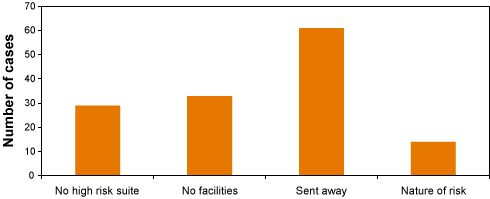
Case study 24 indicates the effect of a perceived risk of infection
Case study 24
Young adult, a 'known drug addict'. Found dead at home. In the supporting documents, the statement
(to coroner from his officer, presumably): "please authorise post mortem[sic] so
we can also test for HIV, Hep B, Hep C" [these turned out to be negative].
The autopsy was limited; no organs were removed separately or weighed. No gross disease in heart, lungs or abdomen was found. There was no skull fracture or bruise of scalp and, "in view of the available history, it was elected not to examine the brain".
Toxicological studies showed significant blood levels of alcohol and methadone, which were given as the cause of death. The advisor noted that fear of infection has drastically and unnecessarily limited the scale of the autopsy, and that the brain could have shown significant pathology.
In 45% (61/137) of the mortuaries that did not accept high risk autopsies, high risk cases were sent away to another site to be performed. Of those autopsies sent away, it was found that 66% (40/61) made a specific reference to CJD. Under the 'nature of risk' category, it appeared to be a fear of contracting an infection that was the driver, these being typical comments as free text:
- "risk to staff";
- "these cases are considered to be too high risk";
- "unnecessary risk";
- "pathologist does not do infectious autopsies".
The implications are interesting. It means that the mortuary staff - pathologists and APTs - have an option to refuse to do certain requested work on grounds of risk to health. There is the expectation that other units will pick up the work, even if it means transporting a body across more than one coronial jurisdiction boundary (which is not permitted under section 22 of the Coroners Act), with the inconvenience and expense entailed. In certain cases, there will be good reasons for such transfers, the main one being suspected CJD as the brain histopathology will have to be examined by a neuropathologist for confirmation of the disease. But for HCV and HIV infections there is no such requirement. For HBV it is extraordinary that mortuaries can refuse this work: all health care workers likely to be exposed to HBV are vaccinated. Does it indicate that they do not believe that the vaccine works, and that the managers of the mortuary do not feel empowered to enforce the employees to undertake requested work that is risky?
The actual risk to staff in the mortuary of acquiring these infections in the course of work is, from all observational reports, minute and orders of magnitude smaller than the daily risks of travelling to and from work5 There are well publicised protocols for risk reduction and for post exposure prophylaxis where this is appropriate. It thus appears that pathologists do not feel obligated under the same GMC requirements for good medical practice as surgeons are: a surgeon cannot refuse to undertake an operation on a person with known or suspected HIV or HCV infection for fear of infection; he/she takes appropriate precautions and does the procedure. It further implies that coroners do not feel empowered to insist that the pathologists and mortuaries use or adopt appropriate precautions, which may also involve some upgrading of the mortuary, and take infectious cases. Finally, it is always noted that the infectious cases that are known to be such are only a fraction of the actual infected cases since many significant infections are not diagnosed in the life time of a patient, and postmortem testing for hazardous infections is not routine.
The study did not ask about pre-autopsy blood testing for possible serious communicable diseases (the usual protocol includes hepatitis B, hepatitis C, and HIV). That there is considerable variation in practice regarding the need for pre-autopsy testing is known to the advisors. The subject is discussed in the RCPath 2002 Guidelines, where the recommendation is that pre-mortem testing is not necessary; universal precautions are the best practice, with infectious disease tests following where appropriate to identify the correct cause of death, or exclude a significant infection. It is time that this issue is grasped at the national level and a uniform approach followed.
The organisational questionnaire examined whether mortuaries had separate suites or rooms for high risk infectious autopsies. In comparison between hospital/combined mortuaries and local authority mortuaries and the availability of a high risk suite/room, 38% (6/16) of local authority mortuaries had access to a separate high risk autopsy suite compared to only 17% (17/174) of hospital/combined mortuaries. In both local authority and hospital/combined mortuaries, a majority did not have access to separate high risk autopsy suites, (56% (9/16) and 77% (135/174) respectively) (Figure 6).
The Health and Safety Advisory Commitee (HSAC) 'Safe working' document3 notes that, for infectious bodies, a separate high risk suite is 'ideal' but it is not essential, as there are many protocols in place to cover pathologists performing high risk autopsies, as well as many precautions that can be taken, such as wearing appropriate hand, face and respiratory protection.
Figure 6: Type of mortuary and availability of high risk infectious autopsy suites
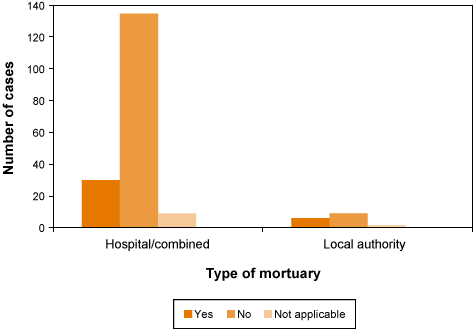
These data are interesting in the light they shine on variation in practice across mortuaries. Some of this is due to strictly inadequate mortuary facilities, i.e. the premises require refurbishment to modern standards (and failure to obtain clinical pathology accreditation (CPA) in a hospital pathology department is frequently due to the poor condition of the mortuary there). But a strong factor is the unwillingness of staff - APT and pathologist - to work on bodies of patients with known or suspected serious communicable diseases. To what extent this matters in terms of quality overall is not certain. The study identified only a little evidence of altered practice because of fear of risk, and the sending away of infected cases to other mortuaries may well have a positive effect as they will be done in centres that are experienced in the type of case.
Because the study did not inspect the protocols that govern individual mortuary management, it is not known how formal are the arrangements for accepting or not accepting infected bodies for individual mortuaries. NCEPOD would suggest that each mortuary review its practices for dealing with such cases in the context of local demand and resources, and make formal agreements with all the interested parties, which includes the coroners and the other units to which cases may be sent.
It is evident from the data in this study, supporting previously known information, that there is no rational national approach to known or suspected serious communicable diseases in cadavers that are scheduled for an autopsy examination. The issues of pre-mortem infection testing, acceptance by mortuaries of infected cases, and the protocols for performing the autopsies need addressing, so that a national standard operates. This can include referring certain cases to specialist centres. Coroners and their officers are central to the process because they request the majority of autopsies on infected bodies.
Recommendation
The approach to infectious disease management in mortuaries should be reviewed and standardised
Clinical pathology accreditation (CPA)
All laboratory facilities in health services, and this includes mortuaries, should function
to certain standards of operation, and the process of inspecting and certifying that these standards operate is through a clinical pathology accreditation organisation. The standards cover all aspects of the work undertaken in the facility. In the UK, the most well known such organisation is Clinical Pathology Accreditation (UK) Ltd.
Seventy seven percent (140/183) of mortuary managers reported having clinical pathology accreditation (CPA). Twenty three percent (43/183) reported not having CPA and the remaining 10 did not know whether or not the facility had CPA. Although reasons as to why mortuaries did not have CPA were not requested, some comments were given as additional information, these included, "CPA accreditation pending" and "in the process of applying for CPA".
NCEPOD also examined whether there was a difference in having CPA between hospital/combined mortuaries and local authority mortuaries (Figure 7). As the graph demonstrates there were more cases of local authority mortuaries 69% (11/16) that did not hold clinical pathology accreditation or equivalent than in hospital mortuaries 18% (32/175). It was acknowledged that CPA Ltd (UK) presently do not accredit non-NHS mortuaries.
Figure 7: Mortuary type by whether or not the mortuary is accredited with CPA
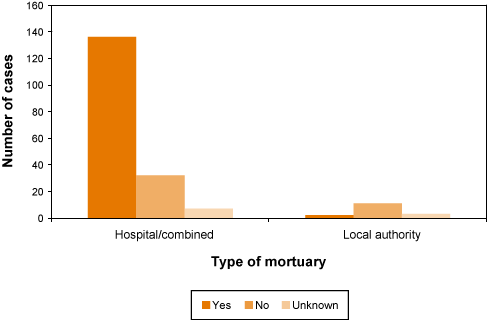
Mortuary workload and CPA were also examined (Table 4).
Table 4: Workload by whether or not the mortuary has CPA
|
| |
Mortuary size |
| <=52 |
53-520 |
521-999 |
>=1000 |
| Yes |
7 |
70 |
55 |
8 |
| No |
1 |
24 |
15 |
3 |
| Unknown |
0 |
4 |
6 |
0 |
| TOTAL |
8 |
98 |
76 |
11 |
Over 70% of mortuaries in each workload category (<52, (7/8); 53-520, (70/98); 521-999, (55/76); >1000 (8/11) had CPA but 27% (3/11) of mortuaries performing over 1000 autopsies per annum did not have accreditation.
The point about accreditation is that to attain the status, a unit (laboratory or mortuary) has to investigate, document and audit all its procedures against a set of generic standards in eight sections6:
- Organisation and quality management system;
- Personnel;
- Premises and environment;
- Equipment, information systems and material;
- Pre-examination process;
- Examination process;
- The post examination phase;
- Evaluation and quality assurance.
The standards against which units are measured are not generated by the clinical accreditation organisation but are derived from widely available best practice, health and safety, staffing levels, management, and many other standards. This is an intensive process that forces the management and health care workers within the unit to see whether they match up to the appropriate best standards. Inevitably it carries a financial cost, which may inhibit some mortuaries unattached to histopathology departments in hospitals from applying for accreditation. In the context of the hitherto unaudited process of the coronial autopsy process, systematic mortuary accreditation can only raise standards across several of the areas that have been highlighted in this report.
In future, all mortuaries, hospital and local authority, that perform autopsies and store human tissues will be required to have a licence from the Human Tissue Authority (HTA)7. There will be governance requirements particularly concerned with documenting tissues removed from bodies and their ultimate fate and disposal. This is a narrower remit than the standards for clinical pathology accreditation. It is not yet clear how the accreditation and licensing processes will interact; but the accreditation general standards will remain important and relevant to autopsy practice.
Recommendation
All mortuaries should be quality accredited.
References
- NHS Estates. HBN 20. Facilities for mortuary and post-mortem room services.
(For information only: NHS Acute Trusts and NHS Foundation Trusts). 2005; Crown Copyright
- The Royal College of Pathologists. Guidelines on autopsy practice. Report of a working group of The Royal College of Pathologists. 2002, Royal College of Pathologists, London
- Health & Safety Advisory Committee: "Safe working and the prevention of infection in the mortuary and post-mortem room", HSE Books, 1st edition 1991, 2nd edition 2003
- Advisory Committee on Dangerous Pathogens, The Approved List of biological agents, Health and Safety Executive, Crown Copyright 2004 www.hse.gov.uk/biosafety/laboratories.htm
- Burton JL. Health and safety at necropsy. J Clin Pathol. 2003; 56:254-60
- Clinical Pathology Accreditation (UK) Ltd. www.cpa-uk.co.uk Accessed 5th May 2006
- HTA website http://www.hta.gov.uk/
|

